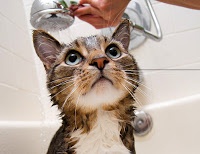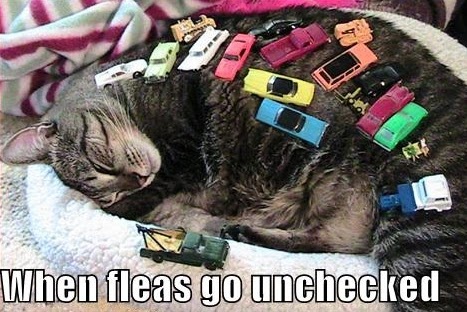Blog
The Trouble With Fleas
August 23, 2013

Fleas have been around for thousands of years. Before the development of our current flea products, fleas were much harder to rid from our pets and home. I remember in 1994 I took care of my Mom's dog in my apartment. He went home after the weekend and soon after my two cats were scratching. I combed them and was surprised to find fleas on my indoor boys.
This was before topical flea products were available, and I was now faced with trying to get the fleas off my cats and out of my apartment. I bathed them (which was not enjoyed by any of us!), washed the rugs and bedding, and vacuumed the floors and upholstery. After a long day of cleaning, I settled into my office to study thinking the fleas were all gone. My cat Hobie came up to me to say hello, and as I reached down to pet him, I saw a flea scuttle across his nose. I was shocked, how could this be after my extreme efforts of cleaning? It took many days to finally get rid of the fleas. I resorted to using a flea comb twice a day to comb out numerous fleas from their coats and vacuumed daily. After a month, I no longer had any signs of fleas.

I am so glad we now have effective flea products to more easily eliminate fleas. Using a topical application that will last for 3–4 weeks is the best method to keep your cats from bringing fleas into your home and setting up a flea infestation. Revolution and Vectra are the two products we have available here to kill fleas. Do not use products you can find in stores not labeled for cats, nor ones that contain amitraz or permethrin as they are toxic.
What I did not understand in the 1990s, before I became a veterinarian, was the life cycle of the flea. Had I known then that one day of cleaning was just the beginning, and it could take up to three months of diligent housekeeping to fully eliminate the fleas, I would not have felt so defeated. The adult fleas live on a cat to feed, and mate, and then the females can lay 20–50 eggs per day. These eggs will fall off the cat and land on the carpet and bedding in your home and hatch in 2–5 days. The flea larvae will then eat the flea dirt and other debris for 8–15 days as they continue to grow, and then spin a cocoon (the pupae stage) to wait. The larvae will stay in the cocoon for up to 12 months until the right temperature and humidity are perceived in your home. When they sense vibration from movement and CO2 from a food source approaching, they will emerge from their pupae as young adult fleas and jump onto a cat to start the life cycle again. Adult fleas can live 30–40 days.

Effective flea control involves removing these stages (eggs, larvae, and pupae) from your home, or the life cycle will continue. Your best defense is to use a vacuum cleaner. The vacuum cleaner accomplishes removing the food source for the larvae, called flea dirt (which is dried blood and excrement produced by adult fleas after they have fed on your pet). The vacuum cleaner's vibration will also stimulate flea larvae to emerge from their cocoons and suck them up into the vacuum bag. A great study was performed at The Ohio State University demonstrating that 96% of adult fleas were killed by vacuuming, and 100% of younger fleas were eliminated.
See also:
- University of California Davis, Flea Management Guidelines
So, don't feel defeated if you find fleas on your cat. You can remove them from your home, but it will take time and effort.



